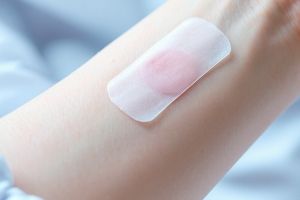drug delivery

Stability, challenges, and prospects of chitosan for the delivery of anticancer drugs and tissue regenerative growth factors
The review article presents various chitosan-based platforms for drug delivery. In particular, systems for cancer treatment and for the delivery of growth factors that promote tissue regeneration.

Chitosan Microparticles As A Drug Delivery System Against Respiratory Tract Infections
Respiratory tract infections (RTIs) are a global health burden. They include a wide range of diseases, from common colds to severe pneumonia. A novel chitosan containing microparticle was developed as a potential drug carrier system for the treatment of RTIs.

Chitosan in polymer-based nanoparticles for drug delivery to the eye
Eye diseases are difficult to treat due to natural factors such as the blood-eye barrier, cornea or tear film. Polymer-based nanoparticles made of chitosan, among others, can help there to improve drug transport. In this article we would like to summarize a review on this topic.

Press release mRNA active ingredients: Protected for an optimized effect
Berlin, Halle, 16.03.2023: Since January of this year, the project "Zielwirk" is developing a new chitosan technology for the efficient release of mRNA active ingredients. The technology aims to ensure that drugs for the treatment of serious diseases can be better absorbed as well as processed by the body. The participating project partners Heppe Medical Chitosan GmbH, FDX Fluid Dynamix GmbH, Martin Luther University Halle-Wittenberg and the Fraunhofer Institute for Production Systems and Design Technology (IPK) are funded by the German Federal Ministry of Economics and Climate Protection (BMWK) with six million euros over three years.

Arginine-chitosan nanoparticles for siRNA transport
Small interfering RNAs (siRNAs) can be used as in gene therapies for e.g. cancers such as leukemia. However, the application of these is limited by a lack of efficient drug delivery. Therefore, in the presented study, chitosan was functionalized with arginine to form nanoparticles, loaded with siRNA, and their properties as siRNA vectors were investigated.

Chitosan-based smart microgels for the treatment of inflammatory bowel diseases
More than 5 million people worldwide are affected by inflammatory bowel disease. To enable good treatment, targeted and efficient drug delivery is necessary. In the presented study, a chitosan-based vancomycin loaded microgel was investigated for this purpose.

Chitosan microparticles for the treatment of HIV-1 infection
Small interferring RNAs (siRNAs) can inactivate viruses by so-called gene silencing. In order to use this process in biomedicine, the transport of unstable siRNAs must be improved. In the presented study, siRNAs are coupled to chitosan microparticles and investigated for the inactivation of viral proteins in HIV-1 infected C8166 cells. siRNA transfection mediated by chitosan microparticles for the treatment of HIV-1 infections of human cell lines

How chitosan can help against breast cancer
Breast cancer will affect one in eight women during their lifetime. Especially metastatic breast cancer has a low survival rate. In this article, we present a review of current research on the use of chitosan in breast cancer therapy and diagnostics.

Chitosan in endometriosis pain treatment
Chronic, painful diseases such as endometriosis can lead to a severe reduction in the quality of life of those affected. Drug delivery systems, such as chitosan-containing hydrogels, could enable efficient pain management with prolonged and targeted drug release. Therefore, in the study presented here, hydrogels made of chitosan and the vanillin derivative 2-hydroxy-5-nitrobenzaldehyde were investigated as a drug delivery system for diclofenac sodium salt.

Beta blockers and chitosan
Due to its biocompatibility and ability to increase the water solubility of drugs, chitosan can be used as an excipient in drug delivery systems. In the following article, we present the influence of physical mixtures of the beta-blocker carvediol (CVD) and chitosan on CVD solubility and release profile.

Water-soluble drug release by chitosan microparticles
Chitosan and chitosan derivatives are promising biopolymers for nasal or vaginal drug delivery using micro- or nanoparticles. However, the pH-dependent solubility of chitosan and excessive water uptake in the presence of ions is suboptimal. Water uptake can result in rapid initial release of the drug due to collapse of the chitosan-based transport vehicle. To stabilize the drug release, research is being conducted to modify the polymer structure by physical crosslinking. Aim of the presented study was to investigate the influence of microparticle composition, in particular the amount of ion crosslinker (CF) introduced, on the release profile of water-soluble drugs from the chitosan matrix.

Chitosan for pulmonary applications
Chitosan is a promising drug delivery system for pulmonary applications and is therefore of particular interest for vaccine development in the Corona Pandemic. The biodegradable and biocompatible polymer's mucoadhesive, permeation-increasing and site-/cell-specific properties are useful in this context. Nanocarriers based on various microencapsulation and micro-nano mixing systems have already been developed. The aerodynamic character is important to enable efficient pulmonary aerosol formation and inhalation. In this article we present research on chitosan as pulmonary particulate anti-infective drug carrier.

Chitosan nanoparticles - potential drug delivery systems for COVID-19 drugs
Chitosan nanoparticles can deliver drugs to their specific target site and release them over a long period. In current corona crisis, chitosan nanoparticles could be one way to release potential COVID-19 drugs specifically in the lungs of affected patients. A potential drug delivery system for the treatment of SARS-CoV-2 infected persons is Novochizol™, consisting of chitosan-based nanoparticles.

Chitosan as adjuvant for vaccines
Adjuvants in vaccines are potent enhancers, which ensure that even small amounts of pathogens induce a permanent immune response. They are particularly necessary for inactivated vaccines and vaccines with antigen subunits. Several studies investigated chitosan as an adjuvant or antigen delivery system in various formulations (gels, aqueous dispersion, micro- and nanoparticles).

Drug delivery systems with chitosan
Biological barriers can limit the availability of a therapeutic agent in the target tissue. Drug delivery systems overcome these limitations to transport the correct dose of drug to its target site. The biopolymer chitosan has great potential for the development of innovative drug delivery systems. We present two articles that explore the treatment of cancer and noise-induced hearing loss with chitosan-based drug delivery systems.

Publications in July & August 2016 - drug delivery systems
Today´s topic is chitosan for drug delivery systems. In July and August 2016, 33 articles about chitosan combined with drug delivery systems were published. As might be expected, top publisher are China (13 articles), United States (5) and India (4). The articles investigated drug release by chitosan-based micro- or nanoparticles, hydrogels and nanocomposites. Thereby controlled release of cytostatics, proteins or peptides was mainly studied. (Source: www.gopubmed.org)

Publication May and June 2013
231 articles about chitosan and chitosan derivatives have been published in May and June 2013. The main topics focused on animal and human studies and on chitosan-based nanoparticles and pharmaceutical preparations. Moreover, the physico-chemical properties and pH sensitivity of various chitosan derivatives were intensively studied. Among the top nations of chitosan research are again: China (76 articles), USA (30) and India (14).

Publications in March and April 2014
In March and April, 234 publications were released about Chitosan, mainly addressing topics like pharmaceutical preparations, nanoparticles, evaluation studies and tissues. The most successful nations in the field of chitosan-related publications are again: China (74 articles), India (24) and USA (19).

Publications in March 2012
Overall 131 articles about chitosan and chitosan derivatives were published in March 2012.
As in the previous month, China is the country with the most publications with overall 35 articles, followed by the USA (14 articles), India (9 articles) and Taiwan (8 articles).

Publications in September 2010
Besides interesting conferences like the ESB Meeting (European Conference on Biomaterials) from September 11 to 15 in Tampere, Finland many international articles about the application of chitosan appeared. As usual, some interesting papers will be presented.

Nanoparticles: Trojan Horse for APIs
The big challenge in the field of medical innovations is so tiny that it is not noticeable with the naked eye. Nanotechnology – a promising and trendsetting technology. For example, with the help of drug-delivery-systems drugs can be transported to an exactly defined part within the body.
Chitosan also produces nanoparticles.

Veröffentlichungen im August 2010
Der Sommer neigt sich zum Ende – das heißt aber nicht, dass die News rund um Chitosan nicht heiß sind. Hier der Review der Chitosan Veröffentlichungen im August. 97 wissenschaftliche Artikel wurden veröffentlicht, in denen mit Chitosan gearbeitet wurde. Im Int J Biol Macromol wurden 8 Artikel veröffentlicht. Die Top drei Nationen bezogen auf die Anzahl der Artikel sind China, USA und Indien, gefolgt von Portugal auf Platz 4.

Chitosan publications in February 2009
In February chitosan research remains very active. After 83 articles in January 73 papers were published in the second month of the year 2009.






